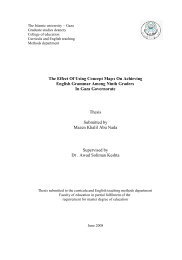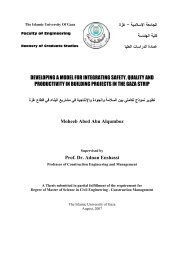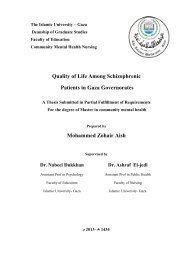A Study of Lean Construction Practices in Gaza Strip
A Study of Lean Construction Practices in Gaza Strip
A Study of Lean Construction Practices in Gaza Strip
Create successful ePaper yourself
Turn your PDF publications into a flip-book with our unique Google optimized e-Paper software.
2.1 <strong>Lean</strong> <strong>Construction</strong> History<br />
Chapter Two<br />
<strong>Lean</strong> <strong>Construction</strong><br />
The lean construction system <strong>in</strong>itially appeared after the Second World War as<br />
“Toyota system” or “lean manufactur<strong>in</strong>g system”. Japan was defeated <strong>in</strong> the war, which<br />
caused a lack <strong>of</strong> f<strong>in</strong>ancial, physical and human resources thus result<strong>in</strong>g <strong>in</strong> the<br />
superiority <strong>of</strong> American companies for the auto <strong>in</strong>dustry over Japanese companies by a<br />
factor <strong>of</strong> 10 cars <strong>in</strong> production.<br />
Then, Toyota leaders (Ohno and others), thought about the creation <strong>of</strong> this system<br />
“Toyota system”.<br />
Taiichi Ohno, who was given the task <strong>of</strong> develop<strong>in</strong>g a system that would<br />
enhance productivity at Toyota, is generally considered to be the primary force beh<strong>in</strong>d<br />
his system. Ohno chose some ideas from the west and particularly from Henry Ford’s<br />
book “Today and tomorrow.” Ford’s mov<strong>in</strong>g assembly l<strong>in</strong>e <strong>of</strong> cont<strong>in</strong>uously flow<strong>in</strong>g<br />
material formed the basis for the Toyota production system. After some<br />
experimentation, the Toyota production system was developed and was called “Just <strong>in</strong><br />
Time” between 1945 and 1970. Then the name was changed <strong>in</strong>to “ <strong>Lean</strong> Production” as<br />
the previous name seemed unsuitable. The system is still grow<strong>in</strong>g today all over the<br />
world. The basic underly<strong>in</strong>g idea <strong>of</strong> this system is to m<strong>in</strong>imize the non value added.<br />
In order to compete <strong>in</strong> today’s fiercely competitive market, US manufacturers<br />
have come to realize that the traditional mass production concept has to be adapted to<br />
the new ideas <strong>of</strong> lean manufactur<strong>in</strong>g. A study that was done at the Massachusetts<br />
Institute <strong>of</strong> Technology <strong>of</strong> the movement from mass production to world lean<br />
manufactur<strong>in</strong>g. The study underscored the great success <strong>of</strong> Toyota at NUMMI (New<br />
United Motor Manufactur<strong>in</strong>g Inc.) and brought out the huge gap that existed between<br />
the Japanese and the western automotive <strong>in</strong>dustry. The ideas came to be adopted <strong>in</strong> the<br />
US because the Japanese companies developed, produced and distributed products with<br />
half or less human effort, capital <strong>in</strong>vestment, floor space, tools, materials, time, and<br />
overall the expense (Abudallah et al., 2003).<br />
4

















